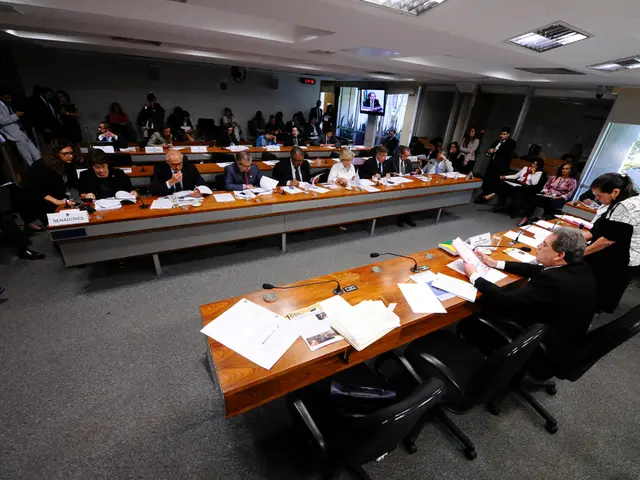Developing a Audio Streaming Platform: Copyright, Elements, and Revenue Strategies
With an ever-growing demand for personalized and hassle-free audio experiences, off-the-shelf streaming solutions are no longer adequate. The music streaming market is poised for impressive growth, with the US sector predicted to reach $42.92 billion by 2029 (Statista). To seize this lucrative opportunity, tailoring your music streaming application is paramount.
In this comprehensive guide, we will walk you through the crucial elements to consider while developing a custom music streaming app from scratch. We will delve into essential features, licensing requirements, and challenges that will ensure your app stands out in a congested market, capitalizing on the burgeoning audio economy.
Streaming has become the norm in the music industry, and users are increasingly drawn to platforms that offer consistent, top-tier experiences. Given the significant user base, streaming service providers have a great opportunity to meet evolving user demands and gain a competitive edge.
Artificial intelligence (AI) is playing a pivotal role, enabling users to demand more personalized solutions. In a connected world, users no longer settle for static playlists, preferring experiences designed to match their preferences and emotions. Features such as Spotify's Discover Weekly are case in point.
To cater to various moods and activities, music streaming apps provide playlists for workouts, road trips, and even melancholic moments. Ensuring seamless navigation and voice control is essential to enhance user experiences. Additionally, catering to diverse age groups, fostering a community, and promoting social sharing will boost retention rates.
Features
To stand out in the crowded market, several core and advanced features are essential in the app development process.
Native (Swift/Kotlin)
Core Features
Cross Platform (Flutter/React Native)
- High-fidelity audio (AAC, FLAC) + offline playback: Offering studio-quality audio and offline playback features can justify a premium price and improve monetization methods.
- Voice control (Alexa/Siri/Google) + cross-device sync: Integrating popular voice assistants and cross-device synchronization ensures seamless user experiences and reduces churn rates.
- Lyrics integration (Musixmatch API) and social sharing: Adding real-time lyrics and social sharing features increases user engagement and promotes virality.
Advanced Tech
Performance
- AI/ML for dynamic recommendations: Implementing AI-backed recommendations provides a personalized journey for users and keeps content fresh to ensure long-term engagement.
- WebRTC for real-time collaborative listening: WebRTC enables group listening sessions and virtual parties, fostering interactive and engaged experiences for users.
Top speed and responsiveness
In the realm of music streaming apps, legal expertise is indispensable to sidestep potential lawsuits. It is essential to navigate the complexities of rights management and fairly compensate artists.
Slow, improves rapidly
US-specific laws to consider while ensuring legal compliance:
- RIAA/ASCAP/BMI Licensing Costs: Obtain licenses from RIAA, ASCAP, and BMI for recorded music and performance rights, with per-stream royalties between $0.003 to $0.008 per play.
- DMCA Takedowns and Copyright Bots: Implement a system for DMCA compliance that can handle copyright takedown requests to deter unauthorized use and mitigate legal exposure.
User Experience
Monetization Strategies That Work
Optimize platform-specific UI
Building a music streaming app goes beyond offering great features; it also entails ensuring sustainable profitability. The following monetization models can help ensure long-term revenue generation.
Consistent, less native-like feel
- Freemium (ads + subscriptions): Offer free access to the app with ads while allowing users to upgrade to ad-free, premium plans for a more enjoyable experience.
- Tiered Plans (student/family bundles): Cater to various demographics by offering flexible pricing options such as student discounts and family packages.
- Ancillary Revenue: NFTs, Merch, Concert Tickets: Diversify income by tapping into high-margin revenue streams like concert tickets, artist merchandise, and NFTs.
In the case study of SoundCloud, fan-powered royalties were instrumental in disrupting the traditional music streaming market. Instead of a pro-rata system, the listener's subscription is allocated proportionally to the artist they listen to the most. This initiative enabled more transparent and representative monetization for small musicians.
Development Time
A strong technical foundation is vital to create a scalable and high-performing streaming app. Some considerations include:
Long: separate codebase
- Backend: Leverage AWS Media Services or Google Cloud's Transcoding for reliable backend development, depending on latency needs, cost, and existing ecosystem compatibility.
- Low-Latency Streaming: Utilize WebSockets and CDN optimization for real-time features like collaborative listening and live events.
- Cost Estimate: Begin with a Minimum Viable Product (MVP) with essential features for a cost of $100,000 to $250,000, and consider scaling up to an enterprise-grade application if necessary.
Faster, single codebase for platforms
Protecting content and user data is crucial while building music streaming solutions. Implementing robust security measures, such as Digital Rights Management (DRM) and enhanced authentication methods, prevents unauthorized use and fosters user trust.
Choosing the right development partner is essential for a successful music streaming app development project. In the process, consider factors such as industry experience, technical competence, UI/UX design expertise, agile methodology, post-launch support, and legal/compliance awareness.
Maintenance
Given the vast opportunities available in the music streaming market, now is the perfect time to turn your music streaming app idea into an outstanding platform. To help with the development process, consider booking a consultation with our experienced music streaming app developers.
Expensive: update per platform
FAQs for Music Streaming App Development
Easy to update across platforms
Q1. What licenses do I need to launch a music streaming app?
A1: To legally stream music, it is essential to obtain necessary licenses from organizations such as ASCAP, BMI, MLC, or Harry Fox Agency, as well as master-use licenses from record labels.
Use Case
Q2. How much does it cost to develop a music streaming app?
Best suited for high-performance and complex apps
A2: The cost for developing a music streaming app can range from $100,000 to $250,000 for an MVP and more than $500,000 for a full-scale, enterprise-grade application, depending on features, platform choice, and licensing fees.
Ideal for MVPs and projects with budget constraints.
- In the dynamic mobile technology landscape, both iOS and Android devices serve as prime platforms for custom music streaming app development.
- For a seamless user experience, opting for native development in Swift (for iOS) and Kotlin (for Android) is advantageous.
- Cross-platform frameworks like Flutter and React Native can also be utilized to develop an application that caters to multiple platforms, striking a balance between cost and quality.
- To stand out in a competitive market, integrating advanced AR features could enhance the user experience and cater to various lifestyle preferences.
- As part of a broader entertainment strategy, collaborating with technology and entertainment giants like Unity could open doors to new monetization opportunities and innovative experiences.
- When developing an app, it's crucial to consider enterprise-level scalability to accommodate a growing user base, ensuring longevity and profitability in the burgeoning audio economy.








